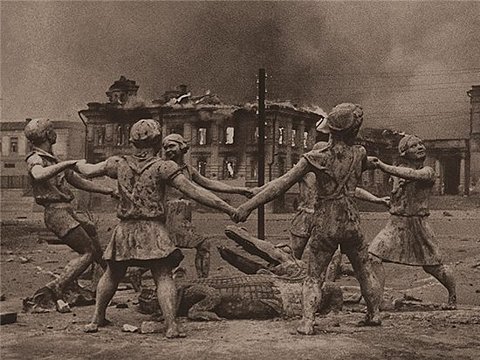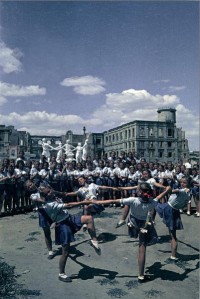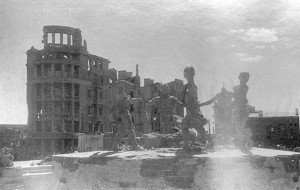Image: Dancing to Save the World October 18, 2010
Author: Beach Combing | in : Contemporary , trackback Mirella over at History and Women has the happy phrase, ‘Wordless Wednesday’, for her regular posts with images. And this ‘wordless’ approach is certainly the sensible one. But Beachcombing gets worryingly loquacious when powerful pictures come up and today is going to be no exception.
Mirella over at History and Women has the happy phrase, ‘Wordless Wednesday’, for her regular posts with images. And this ‘wordless’ approach is certainly the sensible one. But Beachcombing gets worryingly loquacious when powerful pictures come up and today is going to be no exception.
The photograph above was one of a series of the Children’s Khorovod – a statue that used to stand at the Ministry of Defence in Stalingrad – taken by Emmanuil Evzerikhin while the fate of the world was being decided in what was left of that city in 1941.
If ever there was a battle where – to use Kissinger’s description of the Iran-Iraqi war – ‘we want both sides to lose’, then it was this one.
Indeed, perhaps the haunting power of the image derives from the fact that the statue portrays child-like innocence surviving in the face of horror and destruction: childlike innocence that owes nothing to the unpleasant ideologies then fighting for Euro-Asia’s soul.
The fact that in the photographs the children have gunpowder blasts on them and tracer and bullet damage makes Evzerikhin’s work all the more poignant. There is also the rubble strewn at their feet and the blazing building behind. About fifty thousand Russian civilians died in the city: and close to a million and a quarter German and Soviet soldiers, many of them little more than children.
The evidence that Beachcombing has come across suggests that the statue group did not survive the war intact – though it was rapidly repaired afterwards as an icon of national resistance. Certainly the picture below shows the dancing ring broken and the children themselves burnt and destroyed by fire or explosions.
There is also this delightful picture of the statue being recreated in a (1950s?) dance. As regular readers will know Beachcombing is not particularly a fan of the bad old Soviet Union: but he always finds Soviet kitsch of this kind irresistible. Something in the disconcerting combination of uniform/uniformed earnestness and pioneer smiles.
The tableaux of the six children dancing is based on a fairy-tale of obscure origin – Beachcombing would love to know more: drbeachcombing AT yahoo DOT com – in which a crocodile swallows an evil creature. As such the dancing khorovod here is one of celebration around the crocodile ally. But to Beachcombing brought up on dark junk food of the brothers Grimm there is the sense that the children are weaving a pentagram around the beast, keeping it locked within the reptiles’ belly. Perhaps here too is the power of the original photo: menace within the circle and menace without in the city – the children dancing harder and harder to save themselves and their world.
For more images of the Khorovod Statue see this excellent post.
***
1st Nov 2010: Ostrich has written in with some interesting information on the Stalingrad statue. ‘Apparently the figural group represented a popular children’s poem ‘Dr Aybolit’, in which the good doctor persuaded a crocodile to eat an ogre who was terrorising some children. In that interpretation, the children are dancing in celebration and friendship around the crocodile. Most online references seem to be copied from the same source. Oddly, it’s claimed that the fountain was a gift from Ghana (then the Gold Coast colony) to the city of Stalingrad. If true, there must be some remarkable story behind that as well.’ From the links that Ostrich kindly sent in Beachcombing gathers that Doctor Aybolit was a Russian version of Dr Doolittle (the mind boggles…) and that his name meant something like ‘Ow that hurts’… Beachcombing knows that modern Ghana was, in the 1920s and 1930s, under direct and indirect British control: can this statue really have originated in Ghana or as a gift from Ghana? It seems so unlikely, but then so much of history is… Thanks Ostrich!



